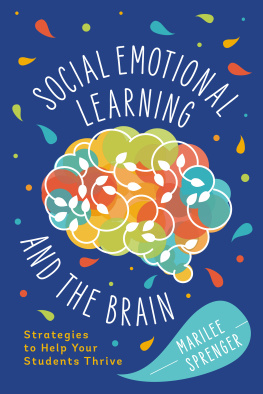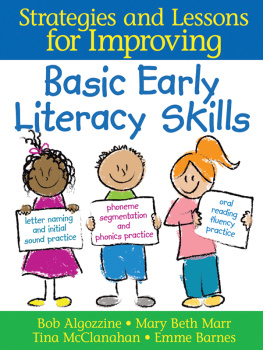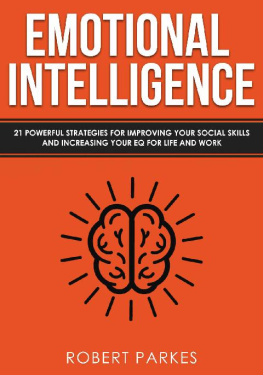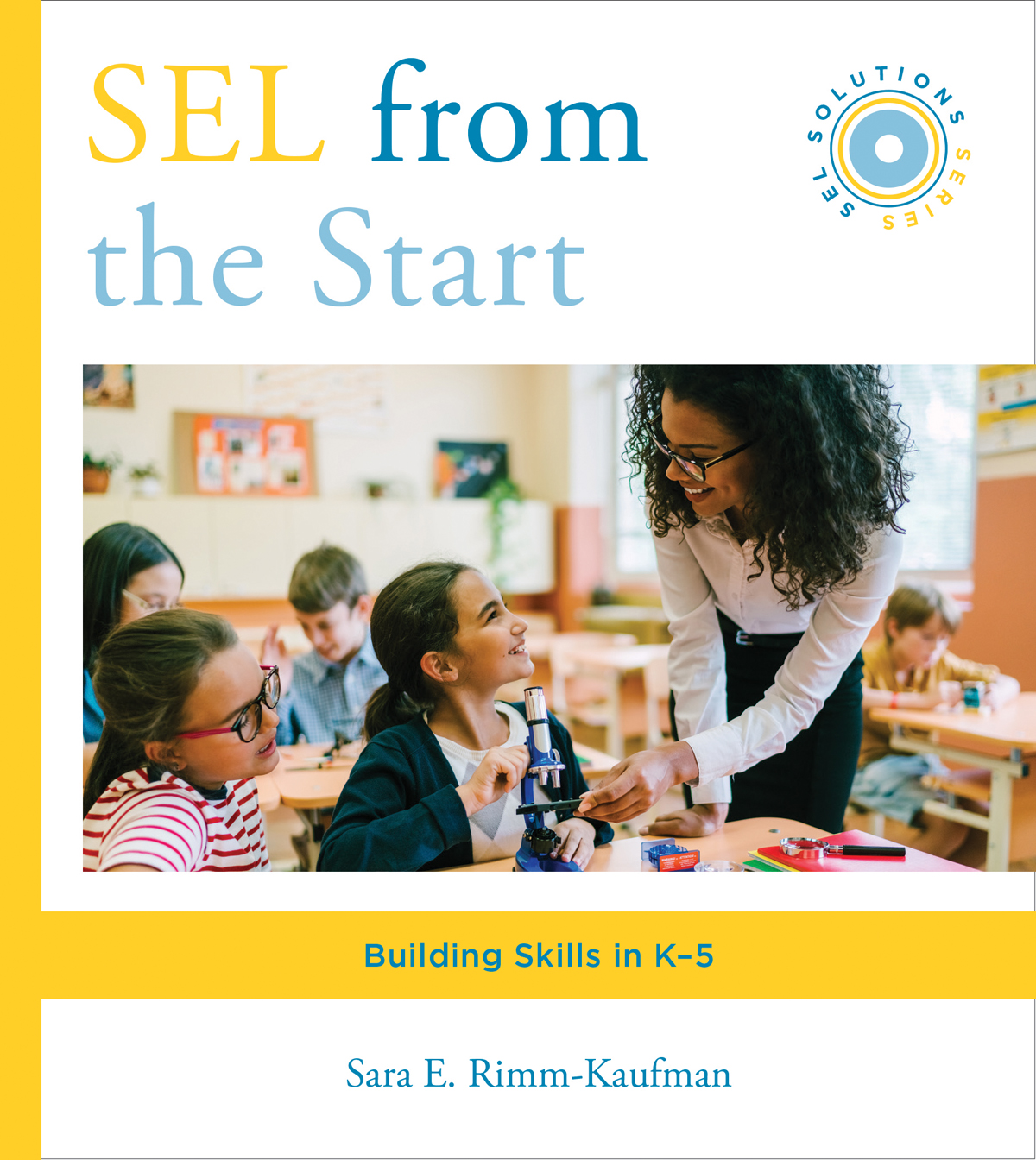
THE NORTON SERIES ON
SOCIAL EMOTIONAL LEARNING SOLUTIONS
PATRICIA A. JENNINGS, SERIES EDITOR
Mindfulness in the Secondary Classroom: A Guide for Teaching Adolescents
Patricia C. Broderick
SEL Every Day: Integrating Social and Emotional Learning with Instruction in Secondary Classrooms
Meena Srinivasan
Assessing Students Social and Emotional Learning: A Guide to Meaningful Measurement
Clark McKown
Mindfulness in the PreK5 Classroom: Helping Students Stress Less and Learn More
Patricia A. Jennings
Preventing Bullying in Schools: A Social and Emotional Learning Approach to Early Intervention
Catherine P. Bradshaw and Tracy Evian Waasdorp
NORTON BOOKS IN EDUCATION
SEL From the Start
Building Skills in K5
SARA E.
RIMM-KAUFMAN

A Norton Professional Book
This e-book contains some places that ask the reader to fill in questions or comments. Please keep pen and paper handy as you read this e-book so that you can complete the exercises within.
To my childrens teachers
Contents
I n Ms. Jacksons fourth grade science class, students were learning about energy systems, building circuits, and discussing energy-related problems related to renewable and nonrenewable resources. After some deep conversations about the trade-offs of using different sources of energy, the class discovered a problem that they wanted to solve. The plastic water bottles that they brought from home, used, and then threw away were made from petroleum that was formed hundreds of millions of years ago. They realized if they kept using up nonrenewable resources like petroleum, there would not be enough to use in the future.
The class launched into action to share their new knowledge with their school community. Small groups worked together on different aspects of the project. One group made Did you know? posters to hang in the cafeteria to teach students about petroleum and plastic. Another group wrote a short announcement about the project to be included in the morning announcements. Yet another prepared a pledge for students to sign if they would commit to using reusable water bottles. More than 300 students signed the pledge. (Apparently, some kindergarteners and first graders signed more than once. The fourth graders had to do some heady calculations to figure out the actual number of signees.) All of the students in the classroom switched to reusable water bottles, held each other accountable, and bubbled with excitement about their progress and impact.
This anecdote comes from a classroom where students are working together to apply what they learn in science class to a real-world problem in their community. The students are mostly from families with limited financial resources, and many are receiving special education services. This teachera cheery, energetic, African American mother of fourbegan her school year focused on boosting students social skills. Through a series of lessons in the first few months of school, she created norms and a caring classroom culture. She supported students ability to listen and speak respectfully to one another, manage strong feelings of frustration, give and receive feedback, and much more. She showed her students that she valued them, and she talked openly about the importance of high-quality relationships, working as a community, and developing the social skills needed to do their best work together. The empty minutes in her classroomtransition time at the start of the day, time waiting in linewere far from empty. She infused those moments with conversation about academic ideas, reflection on social experiences, and comments that helped students get excited and curious about learning. Despite knowing that her students could become loud and chaotic, she was comfortable having a productive classroom where things did not always go perfectly but where students learned and practiced the skills they would need to contribute to a better world. This fourth grade teacher taught social and emotional learning (SEL) from the start.
My goal with this book is to help you start your school year well, by laying a solid foundation for building students social and emotional skills. For the past five years, I have worked with educational content developers and science and service-learning education experts on a project called Connect Science. One part of that work focused on supporting teachers to develop their students social and emotional skills. The hundred or so teachers we worked with loved this work. We heard repeatedly, I want to use these ideas to start my year, and This is the exact content that I need for my classroom right in the beginning of the year, and In the first few weeks, I like to teach students social skills that they will use all year longthis gives me a perfect road map. I prepared this book in response to those elementary school teachers who craved a better way to start their year.
I fully acknowledge the incredible pressures you experience as a teacher. Classroom management issues and student behavior problems are a constant drain on teachers energy. Many teachers feel exhausted. New standards and curricula take time to learn and create additional demands. Students bring a wide variety of challenges from home to your classroom. These are just a few of the things that make teaching hard. And it doesnt stop there: nationally, one in six teachers works a second job to make ends meet (National Center for Educational Statistics, 2018).
With this book, I would like to raise your expectations of what is possible in your classroom, from the very beginning of the year. Giving students the social and emotional skills they need early in the year can start a positive cycle where students feel a sense of connection with others in the classroom and work to keep that good feeling going. Taking the time for SEL when students feel calm is important. No one can learn new skills in the heat of the moment. Teaching students social and emotional skills and practicing those skills when students are relaxed and reflective means they will be able to use these skills when they need them. When students are working well together and seem to be in a groove, you will be less tired from managing difficult behavior and fixing so many problems after they occur.
What Are Social and Emotional Skills?
My hunch is that you have some sort of definition in your head about social and emotional skills. You are probably aware that none of us could actually make it through a morning without using these important skills. But what does this phrase really mean? For our purposes, we use this definition: Social and emotional learning refers to the process through which children and adults understand and manage emotions, set and achieve positive goals, feel and show empathy for others, establish and maintain positive relationships, and make responsible decisions (CASEL, 2019).
In this book, I focus on five social and emotional competencies described by the Collaborative for Academic, Social and Emotional Learning (CASEL, 2019). The following terms are adapted from those advanced by CASEL and enriched with ideas that promote equity based on work by Gregory and Fergus (2017).
Relationship skills refer to the ability to create and sustain productive, healthy, positive relationships with people. These skills include communication, active listening, cooperation, resisting peer pressure, managing and negotiating conflict well, and offering and seeking help as needed. Developing relationship skills incorporates the ability to connect to others across differences in race, ethnicity, religion, age, disability, and social class.









